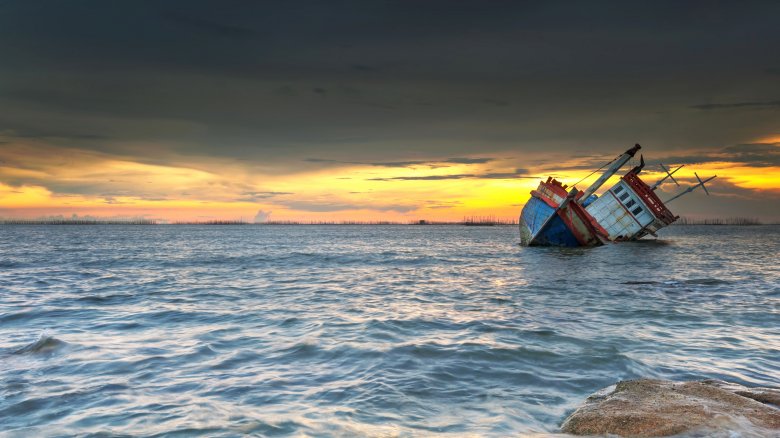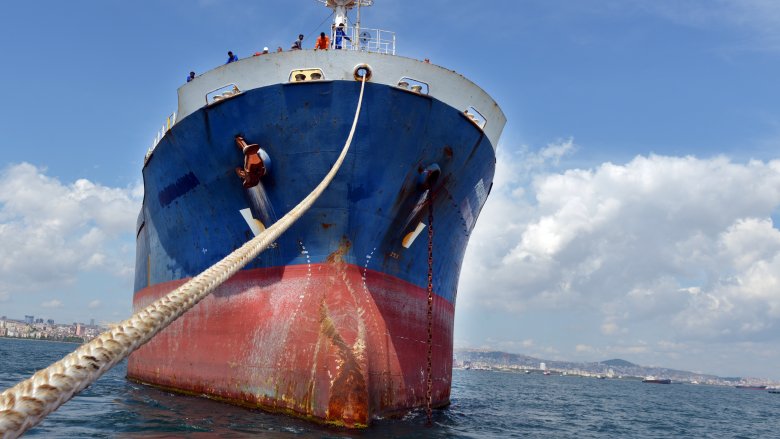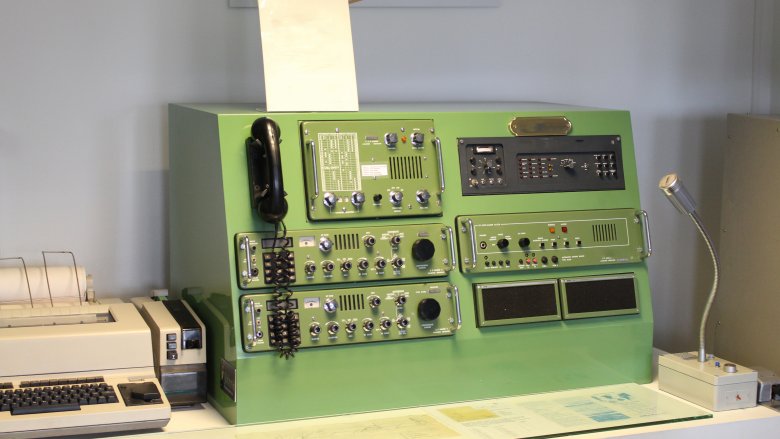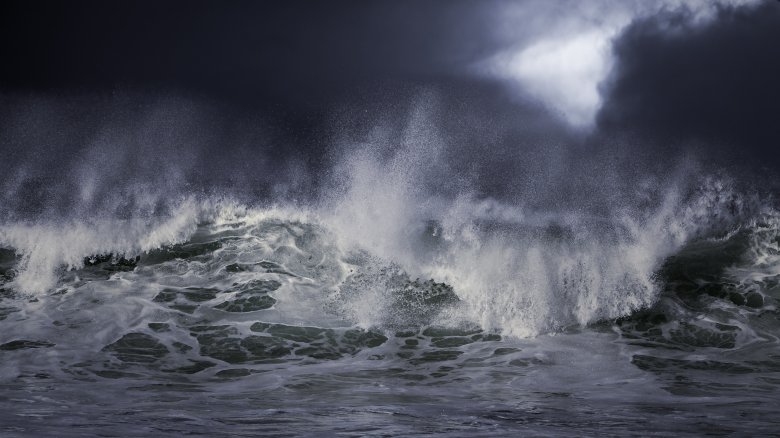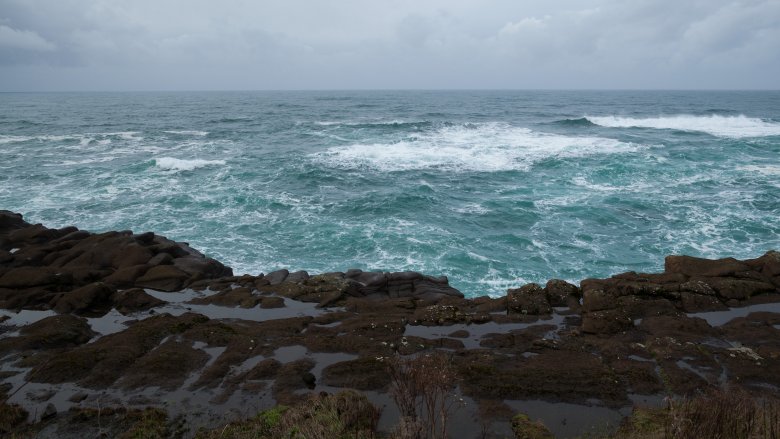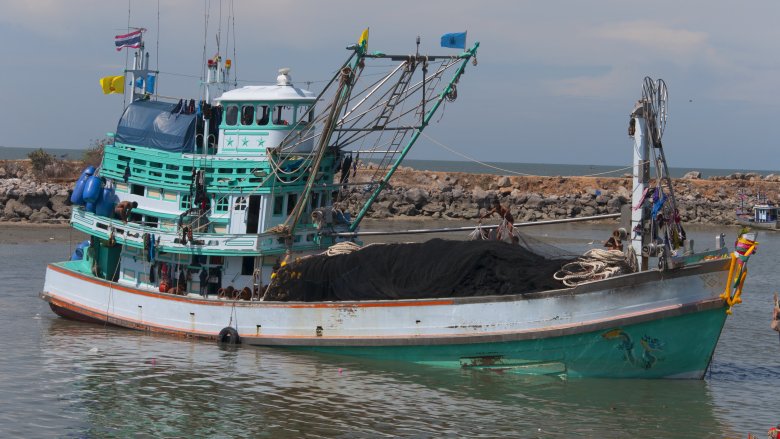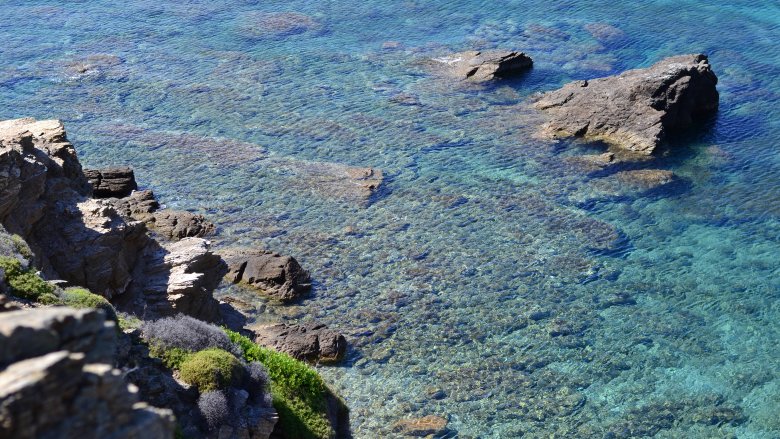The Strange History Of The Devil's Sea
We may receive a commission on purchases made from links.
If you thought mysterious seafaring activity was restricted to the Bermuda Triangle, the Devil's Sea might just shock you to your core. It's a part of the Pacific Ocean, south of Japan, where many large ships were reported missing without a trace in the mid-1950s. Unsurprisingly, this worried the Japanese. Over the years, many amateur sleuths and paranormal theorists have weighed in with theories about electromagnetic disturbances, mythical beings, and time warps, but it wasn't until American author Larry Kusche published The Bermuda Triangle Mystery Solved in 1975 that the world received real answers. (A chapter in the book is devoted to the Devil's Sea.) Wondering what this is all about? Let's visit the bizarre legend in a quest to understand both the facts and fiction that surround these treacherous waters.
What is the origin of the Devil's Sea?
Between 1950 and 1954, nine freight ships carrying functional radio transmitters allegedly went missing in the Pacific. (The exact number, location, and type of ship depends on who you ask.) The weather was calm and there were no documented hazards, but only one of the ships was known to have made a distress call. According to the legend, the lack of bodies or wreckage caused the Japanese government to fear that stretch of the ocean and assume something was amiss. They sent out a team of scientists to investigate, but that ship, the Kaiyo Maru, met a troubling fate of its own. Larry Kusche concludes in his book that, based on correspondence from Japanese science and naval researchers, this well-built and well-equipped ship was "demolished by a volcano or tidal wave." Volcanic activity under the sea wasn't unheard of, but this was something new.
Many writers have said that they referred to it as "Ma-no Umi," or "Sea of the Devil." Before Kusche's work, prominent linguist Charles Berlitz wrote several books about this subject in which he offered extensive but implausible speculations pointing to non-earthly phenomena. Despite Kusche's debunking efforts, Berlitz's sensational theories were hugely popular and his work has sold millions of copies worldwide. His name remains synonymous with conversations surrounding the mystery of the Devil's Sea.
The disappearance of the Toshi-Maru
According to Kusche's book, information about the Devil's Sea originally came from four news clippings from The New York Times. The report from September 30, 1952, indicates that a 60-ton ship named Toshi-Maru disappeared in the same stretch of sea as the Kaiyo-Maru: "A second Japanese vessel may have been swallowed up by the volcanic explosion and tidal wave last week on Myojin Reef, 200 miles south of here, maritime authorities said today," the article states. Equally mysterious, there were no reports about the Toshi-Maru, or the Devil's Sea itself, for 20 years (!) after that.
Determined to get to the bottom of this mystery (which we're very grateful for), Kusche continued to send letters to Japan. He wrote to the American Embassy in Tokyo. He wrote to Japanese newspapers. He wrote to science magazines. Because even though it's a romantic notion to think that magic exists, ships cannot simply go missing.
Real volcanic activity encouraged talk of dragons
If this is the first time you've heard of an underwater volcano, you are not alone. They exist. According to Scientific American, they lie along 37,000 miles of ocean ridges and "spew lava, carbon dioxide and other elements" into the ocean. Because of their erratic behavior, they require regular monitoring by marine geophysicists. In Larry Kusche's 1973 correspondence with Shigeru Kimura, associate editor of the Asahi Shimbun (one of Japan's largest newspapers), Kimura notes that the Myojinsho volcano — the one that enveloped the Kaiyo-maru ship — "becomes active intermittently." The existence of these volcanos is often mentioned along with ancient folklore that describes mythical creatures lurking under the sea, transforming calm waters into intolerably rough ones, and sucking unassuming ships down into their lair. (Apologies for any nightmares this might stir up.) Dragons are particularly common in Japanese mythology, and just like we have superheroes with extraordinary abilities in today's movies and comic books, the dragons were thought to have supernatural powers. As if the Devil's Sea isn't a frightening enough name, it's also referred to as the Dragon's Triangle. The "triangle" part comes from its shape and positioning opposite the Bermuda Triangle.
At last a radio signal, but no relief
In a Yomiuri Shimbun (a Japanese newspaper) article that Kusche cites from January 14, 1955, a 144-ton survey ship called the Shihyo Maru was reported missing in the same ideal weather conditions as the previous disappearances. This ship was supposedly well-equipped and carried a fairly large crew, so its unknown status was troubling. The article mentions a possible explanation for the frequency of ship disappearances: "a rumor that it may be because of some unknown power connected to the 'Atomic Age.'" Are they suggesting some kind of nuclear interference? Of course, such an outlandish theory has never been backed up. A New York Times article cited by Kusche from January 16, 1955, mentions that the fisherman "spoke of a devil lurking off the shore" when the ship's whereabouts were questionable, which fueled the fear of the Devil's Sea. But at last, a radio signal resulted in the ship being located with an unharmed crew and a logical explanation: they had simply run into a bout of normal trouble. There was no great mystery about this ship, but that seemed to only make things worse as the Japanese struggled to find a resolution to the other losses.
The Infamous paranormal activity theorist
In the dust jacket of Charles Berlitz's 1989 book, The Dragon's Triangle, he poses the question: "What is it that lurks in the Dragon's Sea?" The following chapters mention sunken islands, numerous disappearances of ships and planes and submarines, black holes, the staggering loss of life that occurred over many years, ancient legends about sea monsters, and the malfunctioning of radio transmitters aboard research vessels. Although he acknowledges that the series of suspicious events in the Devil's Sea can't seriously be attributed to science fiction, he does sensationalize the hazards of the sea as a possible cause.
Basically, he concludes that the surrounding environment is unnatural and unstable, which warrants an air of mystery. Berlitz mentions that ships have been recorded as disappearing in the Dragon's Triangle for "a thousand years," noting that "some researchers" say three thousand. Frustratingly, these researchers are not named. (Hey, don't think too hard about it, OK?) He also notes that some of the disappearing ships weighed 200,000 tons, which is a lot more than reported in the newspaper articles at the time. Berlitz also discusses UFOs at length, noting that strange flying objects have been sighted in Japan for centuries."It has been speculated that we are always under observing eyes of some alien lifeform," he writes. The book is over 200 pages long, yet the frustrating question posed at the beginning remains open for speculation. Luckily, Berlitz's theories were challenged by other researchers later on.
Electromagnetic disturbances fuel the legend
On account of its inexplicable phenomena, the Devil's Sea is one of the areas in the Northern Hemisphere that is referred to as a vile vortex: supposedly one of ten in the world. The biologist Ivan Sanderson first suggested the concept of vile vortices in his 1972 article The Twelve Devil's Graveyards Around the World (written for Saga magazine and reposted by Paranoia magazine). Vile vortices are essentially anomalies — regions that feature activity that can't easily be explained. Sanderson suggested that radio instruments and compasses were thrown out of whack when pilots flew over the Devil's Sea. Nathan Aaseng notes in his book, The Bermuda Triangle, that the Devil's Sea and the Bermuda Triangle share similar magnetic circumstances, meaning that magnetic compass readings point toward "true north" instead of toward the magnetic pole. He recalls that other writers have suggested black holes and dead radio zones within the Devil's Sea, but he points out that the Navy has not identified any peculiar magnetic disturbances in the area.
Even Gengis Khan's grandson ran into trouble
First things first, this isn't a case in which Kublai Khan, grandson of Genghis Khan who founded the Mongolian Empire, disappeared without a trace in the Devil's Sea. But he did attempt to cross it with his Mongolian fleet in the 13th century in order to invade Japan. The weather turned suddenly and the fleets were struck by a typhoon. Reports say that he lost 40,000 men, including vessels that were obliterated beyond repair. Berlitz notes in The Dragon's Triangle that Khan tried again several years after the first attempt, but his fleets were hit by a gigantic typhoon a second time. There's no mystery about either of these expeditions, just (finally) a mention of intolerable — but totally natural —weather conditions. Suffice to say, Khan's ambitious goal was thwarted.
The Devil's Sea is virtually unknown in Japan
Determined not to give up his quest to discover the mystery of the Devil's Sea, Kusche corresponded with the American Embassy in Tokyo in 1973. Surely, they'd have some answers! Instead, he was informed that the Japanese Government Maritime Safety Agency was not aware of any area known as the Devil's Sea. Even more curious, it didn't have record of issuing warnings in that section of the sea because it wasn't labeled as a danger zone. Kusche received similar responses from Japanese newspapers, which acknowledged the existence of undersea volcanoes and numerous shipwrecks, but didn't think that particular watery expanse was unusual in any way. Shigeru Kimura from the Asahi Shimbun even scanned newspaper articles from the years when the ships were reported missing, and found no mention of the words "Devil's Sea." Perplexing, to say the least.
Japan's naval resources were very basic at the time
In Kusche's correspondence with Shigeru Kimura from November 18, 1973, he explained that Japan wasn't a rich country in the mid-1950s. As far as naval resources, they were very basic. Not all ships had radio transmitters, and if they did, they were notoriously unreliable. Even an experienced sailor can't make an SOS signal with a faulty radio transmitter. Finally, some of this is making some sense.
Kimura goes on to say that many ships were wrecked and ultimately sunk off the coast of Japan, so they could appear to have vanished. Yasuchika Ohno from the Maritime Safety Agency told Kusche on January 10, 1974, that the nine ships were definitely not as advanced as previously indicated, and that the Kaiyo Maru No. 5 was listed as the only survey ship that perished in that time frame. So, those 200,000-ton military vessels carrying hundreds of crew were all part of the legend. It seems that way.
The truth about the sea
Based on his correspondence with Japanese naval officials, Kusche concludes that the majority of ships that "disappeared" in the Devil's Sea were small fishing ships that didn't carry sufficient radio transmitters. The crews couldn't make distress signals, but nothing out of the ordinary occurred on the water. They ran into bad weather and got wrecked. And then they sunk. It's definitely sad and tragic, but it isn't mysterious and it certainly isn't paranormal. (In fact, this situation couldn't be more normal.) Kusche also notes that the ships were lost in a much larger area than originally thought — a 750-mile stretch well outside the area allegedly known as the Devil's Sea.
Thanks to Kusche, we also know that the Kaiyo Maru was not sent out to investigate the strange disappearances of the other ships, but rather to survey the volcanic activity. Lastly, Kimura informed Kusche that the Toshi-Maru was found soon after its "disappearance," having experienced regular, boring old engine trouble. Ooooooo, scary.
The history of the Devil's Sea is undoubtedly very strange, but not because of mysterious disappearances. It's strange because it seems to be an entirely made-up story, the result of many people making grand speculations about things they know nothing about. As Kusche points out, the legends were reported so many times that they eventually became accepted as fact. One thing that can't be disputed? It's a great story.
